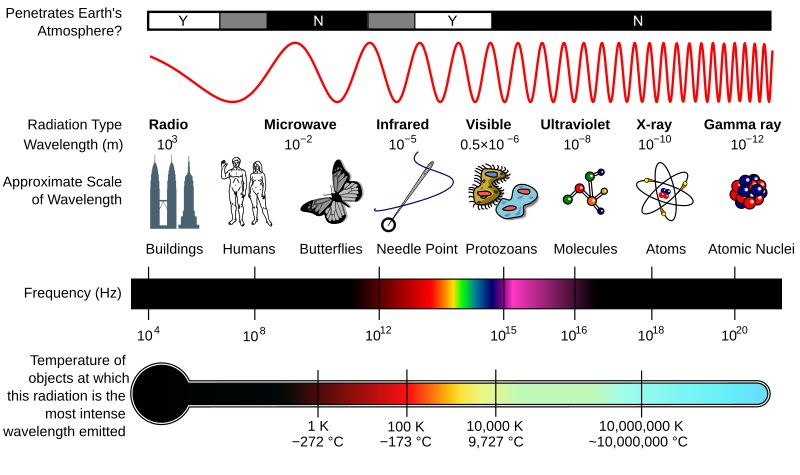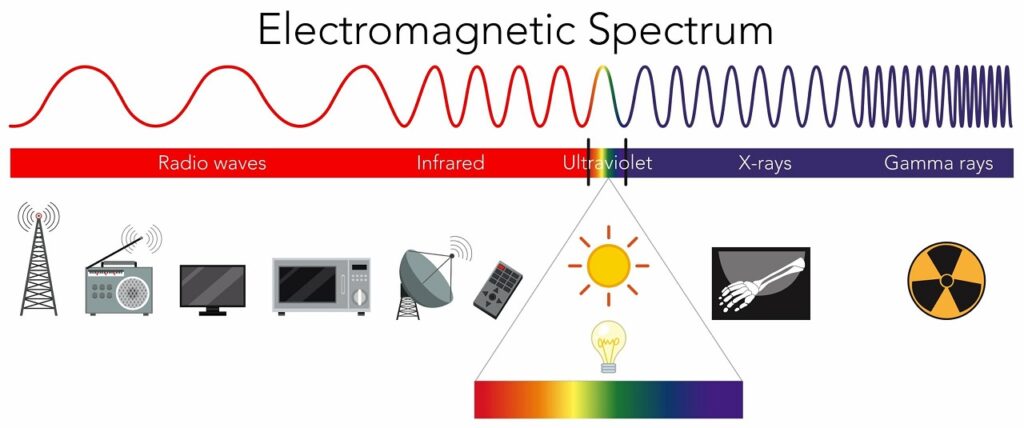Electromagnetic radiation, also known as light. It can be divided into different ranges, spectrum: according to radiation energy, wavelength or frequency. This way, for example, it is possible to identify what substances are/were present in a given segment of space.
Types of radiation: radio waves, microwave radiation, infrared (thermal) radiation, visible light, ultraviolet radiation, X-rays and gamma rays.
Visible light
Visible light or spectrum, is what the human eye can perceive. A compound is colored when the electrons in its molecules can be excited by the energy of the light we see. Basically, everything is white and black. Black is when the material absorbs the light that hits it in the entire wavelength range. White is when it reflects it. Black always remains black, while white is the color we use to illuminate it.
Infrared radiation
We can no longer perceive this with our eyes, only as a thermal effect. Most of the infrared rays coming from outer space are filtered by our atmosphere. The Latin word infra means: below. Because this type of “radiation band” begins below the sub-red range of visible light. Infrared is detected, for example, by night vision. Infrared waves are used in telecommunications, for missiles, etc.
Radio waves, microwaves
We use the frequencies in this range for telecommunications, for example: mobile, television, radio, radar. Microwaves are used in medicine, mainly in the musculoskeletal area, to heat tissues. In a microwave oven, the electromagnetic field forces certain molecules to move. However, there are molecules that are stationary. They are the reason why microwaves have a turntable.
Ultraviolet radiation
Ultraviolet or ultraviola radiation. It comes to us mainly from the Sun, but it can also be produced during lightning strikes and can also be produced artificially. We distinguish 3 types:
UV – A: most of the radiation that reaches us comes from this range. It is constantly present, passes through (general) windows, clouds, etc. It is responsible for skin aging and the development of skin cancer (this radiation can destroy DNA itself). It burns, it only tans us in the short term.
UV – B: helps our body produce vitamin D, we tan from it in the long term. Its strength varies, it is strongest at noon, and it passes through clouds filtered. This radiation can also damage the eyes, not just the skin.
UV – C: Only pilots and astronauts can “encounter” this intensity of radiation. Our Earth’s atmosphere filters it out. It has a sterilizing and highly carcinogenic effect. One chemical-free, environmentally friendly method of disinfection is, for example, the UVC lamp, which is increasingly being used by professionals.
Some living things can see in this range, such as bees.
X-rays
The Earth’s atmosphere absorbs them. They are created by certain electron processes. They are most “useful” in medical diagnostics, we can also identify some atoms with them. They are also used in the food industry: preservation, quality control, sterilization. And they are also a great help in crystallography.
Gamma rays
Our planet’s atmosphere does not let them through. Gamma rays are created when atomic nuclei undergo transformation. We use them for food preservation, for cancer treatments, and for testing materials. However, they can cause burns, genetic mutations, and cancer.
Every element we know has its own spectrum.

The study of the light emitted by objects is called spectroscopy. Among other things, in light of the above and “How to make the invisible visible to the human eye?” knowledge, we can determine with space telescopes what the various stars, and the Universe contain or may have once contained.
Be a Nerdy Bird!

